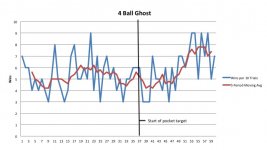Yes you can. You are only considering the OB going into the rail first. What about when the cue ball goes rail first in to the OB. Then the rail is part of the equation.
Do you even understand the intent of the OP ?
Nevermind.
Last edited:
Yes you can. You are only considering the OB going into the rail first. What about when the cue ball goes rail first in to the OB. Then the rail is part of the equation.
I very much tend to agree. Sometimes I shoot some shots without even actually ever looking at the pocket. I just know where it is relative to where the OB is on the table & can 'see' it in my periphreal vision. I believe that is also a claim of CTE, not having to look at the pocket.
Other times, on more full cut shots where the pocket is beyond the 'aim' line of the CB to OB I am 'aiming' at or just inside or outside of a pocket point. Perhaps this is because I am rarely shooting with a center CB hit targeted at the middle of the pocket. I'm targeting one side or another with some form of off center hit on the CB. The only time I 'aim' an OB at a specific exact spot is when shooting combinations or bank shots.
Like CJ Wiley has said several times, it is easy to make this game complicated but the goal should be to keep it as simple as possible. Sometimes it just seems that we are looking for a crutch that will help but it is very difficult to run fast while on crutches.
I doubt that I am the only one that shoots this way, but I could be wrong.
Regards to You &
I agree with this. I think a mark in the pocket or some other visual clue is useful to help form the image, such as "the object ball going exactly along the rail groove on the left jaw of the pocket" to avoid an obstructing ball on the right side....
The time to concentrate on the object ball is right BEFORE we hit the cue ball and then FOLLOW the object ball in the pocket (with our eyes).
It's very important, in my opinion, to see exactly which part of the pocket the object ball goes in.....this process is what will give you the {visual} "feel for the pocket" that so many Champion players talk about.
I agree with this. I think a mark in the pocket or some other visual clue is useful to help form the image, such as "the object ball going exactly along the rail groove on the left jaw of the pocket" to avoid an obstructing ball on the right side.
Lots of beginning players haven't learned to form any kind of image and for them I think a specific point, such as a donut, is useful for training.
Edit, I just saw your picture.
It doesn't matter if its off 1 or 2 mm. Its the idea of aiming at something discrete instead of an "area" that is a "black hole".
I found in play, even if the particular pocket target was not "100 % exactly", I could still find a suitable target that was "close enough", and still better than aiming at a black hole.
Again, this is for me. Everyone is different.
Good shooting.
That's your opinion.
In mine you missed the pocket unless your telling me that you purposely aimed your shot specifically into the rail. Seems kinda of a silly thing to do when the "pocket" should be your target.
When you miss the pocket you aimed for and the ball still manages to fall in , I consider that slop. Perhaps my standards are too high. I can live with that.

P.S. I guess you consider the gutter part of the lane when bowling as well ?
EDIT:
Just want to clarify what the point of this topic was in case you didn't read the first post.
The "point" was establishing a method for finding a center of pocket reference that applies equally from all possible angles on the table. You simply can not include points on the rail as a valid part of that equation. Or any other reference for that matter that does not apply to the criteria specified. (All angles on the table)

I don't get it. Why do you look at the pocket?
As to aiming for different parts of the pocket, I doubt you could play position
with much precision if you don't aim at various parts of the pocket.
Dale(maybe it's just me)